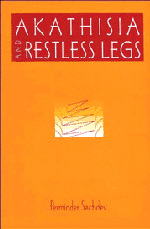Book contents
- Frontmatter
- Contents
- Foreword
- Acknowledgements
- Abbreviations
- Part I Introduction
- Part II Drug-induced akathisia
- Part III Restless legs syndrome
- 12 Restless legs syndrome: clinical features and pathophysiology
- 13 Treatment of restless legs syndrome
- Part IV Conclusions
- Appendix A Haskovec's Akathisie
- Appendix B Prince Henry Hospital Akathisia Scale
- Appendix C Barnes (1989) Akathisia Rating Scale
- Appendix D Hillside Akathisia Scale (version 4)
- References
- Index
12 - Restless legs syndrome: clinical features and pathophysiology
from Part III - Restless legs syndrome
Published online by Cambridge University Press: 12 September 2009
- Frontmatter
- Contents
- Foreword
- Acknowledgements
- Abbreviations
- Part I Introduction
- Part II Drug-induced akathisia
- Part III Restless legs syndrome
- 12 Restless legs syndrome: clinical features and pathophysiology
- 13 Treatment of restless legs syndrome
- Part IV Conclusions
- Appendix A Haskovec's Akathisie
- Appendix B Prince Henry Hospital Akathisia Scale
- Appendix C Barnes (1989) Akathisia Rating Scale
- Appendix D Hillside Akathisia Scale (version 4)
- References
- Index
Summary
Introduction
The early history of the concept of RLS was discussed in Chapter 1. By the 1960s, the syndrome was well accepted and had found its way into the major textbooks of neurology (Grinker and Sahs, 1966; Brain and Walton, 1969). It was no longer considered a psychogenic or ‘psychosomatic’ disorder, and its organic basis was generally recognized. However, the descriptions were still sparse, and only a few authors had provided accounts of their clinical experience. The most comprehensive account was, of course, that of a series of 175 personal cases described by Ekbom (1960). Other series published in the 1960s included 22 cases seen by Bornstein (1961), 27 by Gorman et al (1965) and 38 by Morgan (1967).
Subsequent reviews have supported the main features described by these authors, and have also highlighted the diversity of the syndrome, identifying new features and associations. Ekbom (1945) had noted a familial aggregation in some cases. More detailed descriptions of familial RLS have been published (eg, Lugaresi et al, 1965; Coccagna et al, 1966; Boghen and Peyronnard, 1976; Montplaisir et al, 1985; Watson and Hollander, 1987; Walters et al, 1990), and an autosomal inheritance pattern of a proportion of RLS is now recognized. A number of symptomatic cases of RLS have been described in association with neurological, metabolic and vascular disorders (see later).
In 1953, Symonds published the description of intense myoclonic jerks which appeared on falling asleep and persisted throughout sleep.
- Type
- Chapter
- Information
- Akathisia and Restless Legs , pp. 295 - 325Publisher: Cambridge University PressPrint publication year: 1995



